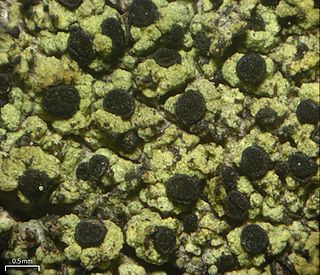
Calicium is a genus of leprose lichen lichens. It is in the family Caliciaceae.

Pentanema salicinum is a plant species in the family Asteraceae. It is found across Eurasia from Portugal to Japan. It has been reported growing in the wild in a few scattered locations in North America but it has not become widely established there.

The Caliciaceae are a family of mostly lichen-forming fungi belonging to the class Lecanoromycetes in the division Ascomycota. Although the family has had its classification changed several times throughout its taxonomic history, the use of modern molecular phylogenetic methods have helped to establish its current placement in the order Caliciales. Caliciaceae contains 36 genera and about 600 species. The largest genus is Buellia, with around 300 species; there are more than a dozen genera that contain only a single species.
Xylomelum benthamii is a plant in the woody pear genus of the family Proteaceae. It was formerly considered a variety of Xylomelum pyriforme. It is native to south-eastern Queensland, Australia, and was described from material collected on 25 June 1829 on the Brisbane River some 140 km north-west of what is now Brisbane, the state capital. It was mistakenly linked with the name Xylomelum salicinum (Meisn.) Benth., and was given the replacement name X. benthamii in 2007 by A.E. Orchard, with the specific epithet honouring botanist George Bentham.
Xylomelum scottianum is a shrub or small tree in the woody pear genus of the family Proteaceae that is commonly known as the northern woody pear. It grows to 10 m in height. endemic to Australia, it is widespread in dry areas of Cape York Peninsula, Queensland, and on Thursday Island in Torres Strait. It is common on sandy soils in open forests, at altitudes of up to 440 m above sea level. It flowers from October to May. The brown seeds are 68–75 mm long. It was used medicinally by the Aboriginal people, as an infusion of the bark and leaves, drunk to relieve internal pain.
Calicium sequoiae is a crustose lichen that has only been found growing on old-growth redwood trees in California. It is a species of pin lichen in the family Caliciaceae. Apothecia are white-powder coated (pruinose). The unusual spores have spiral ridges.
Calicium abietinum, commonly known as fir pin or black stubble, is a crustose lichen that is found growing on trees throughout much of the world.
Calicium chlorosporum is a crustose lichen that is found growing on trees throughout much of the world.
Calicium glaucellum is a crustose lichen that is found growing on trees throughout much of the world.
Calicium laevigatum is a crustose lichen that is found growing on trees in the South West region of Western Australia.
Calicium lenticulare is a crustose lichen that is found growing on trees in the South West region of Western Australia.
Calicium robustellum is a crustose lichen that is found growing on trees in the Gascoyne region of Western Australia and in Queensland.
Calicium tricolor is a crustose lichen that is found growing on trees in the South West region of Western Australia.
Calicium victorianum is a crustose lichen that is found growing on trees and wooden materials.
Chaenothecopsis vainioana is a species of lichenicolous fungus in the family Caliciaceae that is found in Europe. It was first formally described by Czech lichenologist Josef Nádvorník in 1940 as a member of the genus Calicium. The specific epithet honours Finnish lichenologist Edvard August Vainio. Leif Tibell transferred it to genus Chaenothecopsis in 1979. Calicium vainioanum has been reported growing on Arthonia, Lecanactis abietina, and Calicium salicinum.

Calicium viride, commonly known as the green stubble lichen, is a species of pin lichen in the family Caliciaceae, and the type species of the genus Calicium. It is a common and widely distributed species in temperate areas of the Northern Hemisphere and southern South America.

Calicium trabinellum, commonly known as the yellow-collar stubble lichen, is a widespread species of pin lichen in the family Caliciaceae. It was first described by Swedish lichenologist Erik Acharius in 1803 as Calicium xylonellum ß trabinellum. He made the new combination Calicium trabinellum in a later chapter of the same publication.
Calicium carolinianum is a species of lichen in the family Caliciaceae. It is endemic to the Gulf Coastal Plain region of the United States. The lichen contains norstictic acid, and has ascospores that measure 13–17 by 8–9 μm.

Calicium pinicola is a species of lignicolous (wood-dwelling), crustose lichen in the family Caliciaceae. It is widely distributed in Europe, and also occurs in the United States.





